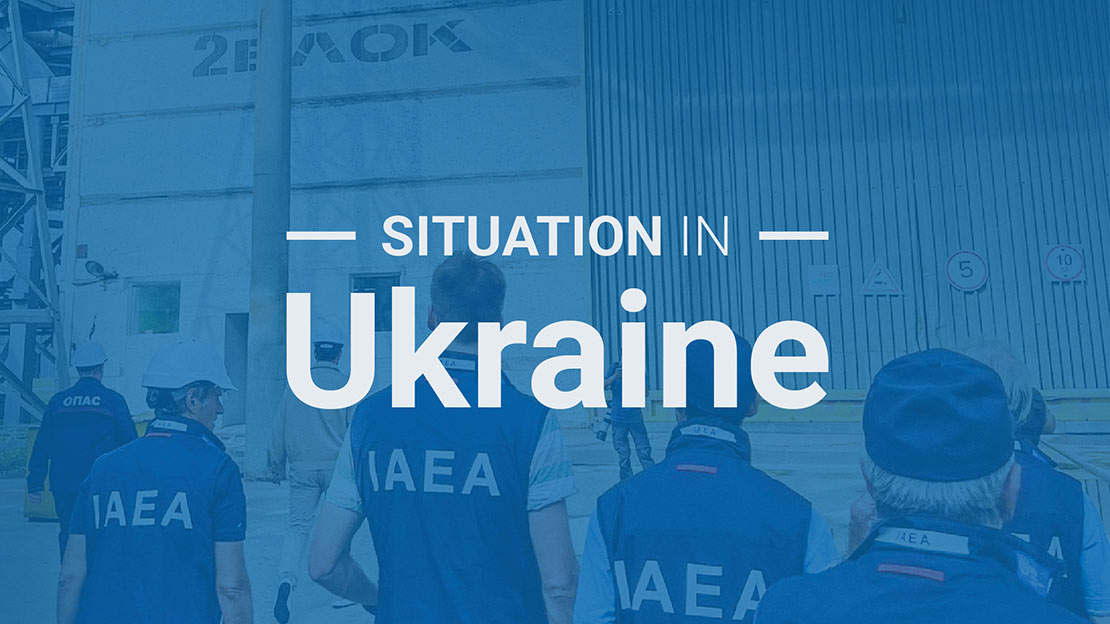Update 320 – IAEA Director General Statement on Situation in Ukraine
IAEA Director General Rafael Mariano Grossi said today that a process had been set in motion to help restore external electricity to Ukraine’s Zaporizhzhya Nuclear Power Plant (ZNPP), following frequent contacts with both sides in recent weeks to address the site’s latest loss of off-site power during the military conflict.
Since the ZNPP last month once again lost all access to the grid, Director General Grossi has been engaging with the Russian Federation and Ukraine on concrete proposals aimed at enabling the plant to receive the off-site power it needs to cool its six shutdown reactors and its spent fuel.
The focus has been on creating the necessary security conditions for repairs to be carried out on the damaged sections of the 750 kilovolt (kV) Dniprovska and the 330 kV Ferosplavna-1 power lines, located on opposite sides of the frontline near the ZNPP.
“Following intensive consultations, the process leading to the re-establishment of off-site power – through the Dniprovska and Ferosplavna-1 lines – has started,” Director General Grossi said.
“While it will still take some time before the grid connection of the Zaporizhzhya Nuclear Power Plant has been restored, the two sides have engaged with us in a constructive way to achieve this important objective for the sake of nuclear safety and security. No one stands to gain from a further deterioration in this regard,” he said.
For the tenth time during the conflict, the ZNPP lost its connection to the grid on 23 September when its last remaining 750 kV power line was cut, almost five months after the last 330 kV back-up line was also disconnected. Both sides blamed the damage on military activities.
For more than two weeks, Europe’s largest nuclear power plant (NPP) has therefore been forced to rely on emergency diesel generators (EDGs) to power its cooling pumps, further challenging an already precarious nuclear safety and security situation at the site.
At the ZNPP, seven EDGs are currently operating and another 13 are on standby. The plant continues to alternate them to produce the electricity it requires, including also for the reactor safety systems.
Based on regularly received nuclear safety data, the IAEA team at the site continues to confirm that there has been no temperature increase within the coolant in the reactors or the spent fuel pools – indicating that the fuel continues to be cooled effectively.
Earlier this week, the team conducted a walkdown to observe the status of the EDGs that were in standby mode at the time. The team also confirmed that the essential service sprinkler ponds – which provide cooling to the reactors and the spent fuel pools – were operating as usual. Radiation levels at the site also remain normal, the team reported.
The team continues to report military activities at various distances from the site. On Tuesday evening, the team members heard five explosions one after the other, occurring close to the site and shaking windows in their building.
The IAEA teams based at the other nuclear sites in Ukraine – Khmelnitskyy, Rivne, South Ukraine and Chornobyl – also report military activities on most days.
On 4 October, the team at the Khmelnitskyy NPP was informed that 16 drones were recorded near the site, the closest 5.5km away from the site. The following day, three drones were detected at the same distance north of the South Ukraine NPP.
The Chornobyl site still has no access to the 330 kV power line that was disconnected last week, reportedly due to military strikes on an electrical substation approximately 40km away, near the town of Slavutych.
Under the IAEA’s comprehensive assistance programme for nuclear safety and security, the Khmelnitskyy NPP this week received radiation survey meters that were procured with funding from the Czech Republic and Japan. It was the 159th delivery of equipment so far, with the value of all deliveries during the conflict now totaling 20 million euros.
